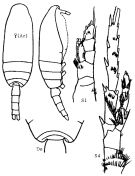|
|
 |
|
Calanoida ( Order ) |
|
|
|
Spinocalanoidea ( Superfamily ) |
|
|
|
Spinocalanidae ( Family ) |
|
|
|
Spinocalanus ( Genus ) |
|
|
| |
Spinocalanus longispinus Brodsky, 1950 (F,M) | |
| | | | | | | Syn.: | Spinocalanus horridus (part.): Damkaer,1975 (p.37, figs.F) | | | | Ref.: | | | Brodsky, 1950 (1967) (p.132, Descr.F, figs.F); Harding, 1966 (p.29, Rem.); Vidal, 1971 a (p.18, 24, 119, figs.F,M, Rem.M); Brodsky & al., 1983 (p.274, figs.F,M, Rem.); Sirenko & al., 1996 (p.349) |  issued from : Brodsky K.A., Vyshkvartseva N.V., Kos M.S. & Markhaseva E.L. in Opred. Faune SSSR, 1983, 135. [p.275, Fig.129]. Female. Gnb = first inner lobe of Mx1; p md = palp of Md; Md: masticatory edge of Md; Gn: genital field (ventral).
|
 issued from : Brodsky K.A., Vyshkvartseva N.V., Kos M.S. & Markhaseva E.L. in Opred. Faune SSSR, 1983, 135. [p.276, Fig.130]. Male. P1-4 = swimming legs incomplete; lb = left
|
 Issued from : K.A. Brodskii in Calanoida of the Far Eastern Seas and Polar Basin of the USSR. Opred. Fauna SSSR, 1950, 35 (Israel Program for Scientific Translations, Jerusalem, 1967) [p.132, Fig.51]. Female (from Central part Arctic Ocean): habitus (dorsal and lateral right side); Do, posterior thoracic segments (dorsal); S1, P1; S4, P4. Nota: 4th and 5th thoracic segments separate, corners rounded, not produced bascward. Cephalothoras 2.33 times longer than abddomen. Genital segment slightly longer than 1.5 times the following segments, ventral process laterally rectangular, and serrate margin. Caudal rami almost as long as anal segment. 2 nd abdominal segment bearing ventral bundle of bristles. A1 longer than body by 1.5 distal segments
|
 Issued from : M. Bode, S. Laakmann, P. Kaiser, W. Hagen, H. Auel & A. Cornils in J. Plankton Res., 2017, 39 (4). [p.605, Table I]. As S. longispinus/stellatus female (from SE Atlantic). Species identified via morphological and molecular analyses, including the number of specimens used for each identification method (MI: morphological identification, COI: cytochrome c oxydase subunit I gene fragment, MS: MALDI-TOF analysis, 18 S: ribosomal 18 S gene fragment). Cryptic lineages were revealed only after molecular analysis. Sampling depth, latitude, total length (TL) and Prosome/Urosome ratio (Pr:Ur) of taxon were recorded. morphological characters are only listed here, if the identification was ambiguous due to missing body parts or if crypticf or pseudocryptic lineages were revealed during molecular analyses. For diagnostic character of species refer to the references: Park, 1970; Grice, 1971; Damkaer, 1975; Schulz, 1989, 1996. C = coxopodite; B = basipodite; P = swimming legs. Nota: This form bear morophological characteristics of both species: very conspicuous ventrolateral edges of the cephalosome (''shoulders'') and metasomal spinules on the left sidfe of the cephalosome, as described for S. longispinus Brodsky, 1950. In contrast, the spine comb on the coxa of Mxp was clearly on a protrusion, similar to descriptions of S. stellatus Brodsky, 1950.. Thes two species are currently not generally accepted and ranked among S. horridus (Worms Editorial Board, 2015) [without true demonstration. CR]. S. horridus was much more spinulose on both sides of the cephalosome and had very long spines on the basis of Mxp.
| | | | | Compl. Ref.: | | | Harding, 1966 (p.17, 71); Dunbar & Harding, 1968 (p.315, 319, Rem.: p.324); Sameoto, 1984 (p.213, Table 1); Kosobokova & al., 1998 (tab.2); Kosobokova & Hirche, 2000 (p.2029, tab.2); Auel & Hagen, 2002 (p.1013, tab.2); Galbraith, 2009 (pers. comm.) | | | | NZ: | 3 | | |
|
Distribution map of Spinocalanus longispinus by geographical zones
|
| | | | Loc: | | | Arct. (Fletcher's Ice Is., Laptev Sea, Lomonosov Ridge), Japan (in Furuhashi, 1966, p.306), off British Columbia (rare), N Baffin Sea | | | | N: | 11 | | | | Lg.: | | | (22) F: 2,5-2,1; (131) F: 3,2-2,28; M: 2,6-2,1; {F: 2,10-3,20; M: 2,10-2,60} | | | | Rem.: | Bathy-abyssal.
This species was maintained contrary to the opinion of Damkaer, 1975 (p.37). After Bode & al. (2017, p.612), high morphological similarities explain why species initially described as S. longispinus is currently synonymised with S. horridus. | | | Last update : 27/03/2020 | |
|
|
 Any use of this site for a publication will be mentioned with the following reference : Any use of this site for a publication will be mentioned with the following reference :
Razouls C., Desreumaux N., Kouwenberg J. and de Bovée F., 2005-2025. - Biodiversity of Marine Planktonic Copepods (morphology, geographical distribution and biological data). Sorbonne University, CNRS. Available at http://copepodes.obs-banyuls.fr/en [Accessed June 04, 2025] © copyright 2005-2025 Sorbonne University, CNRS
|
|
 |
 |






